Key takeaways:
- Anti-war activism is deeply personal, driven by individual stories that reflect the human cost of conflict.
- Global travel fosters empathy and understanding, revealing the interconnectedness of human experiences across cultures.
- Grassroots movements and local peace initiatives are crucial for effective change, highlighting the importance of community-led efforts in healing after conflict.
- Activism thrives on shared experiences, requiring genuine engagement and listening to the voices of those affected by war.
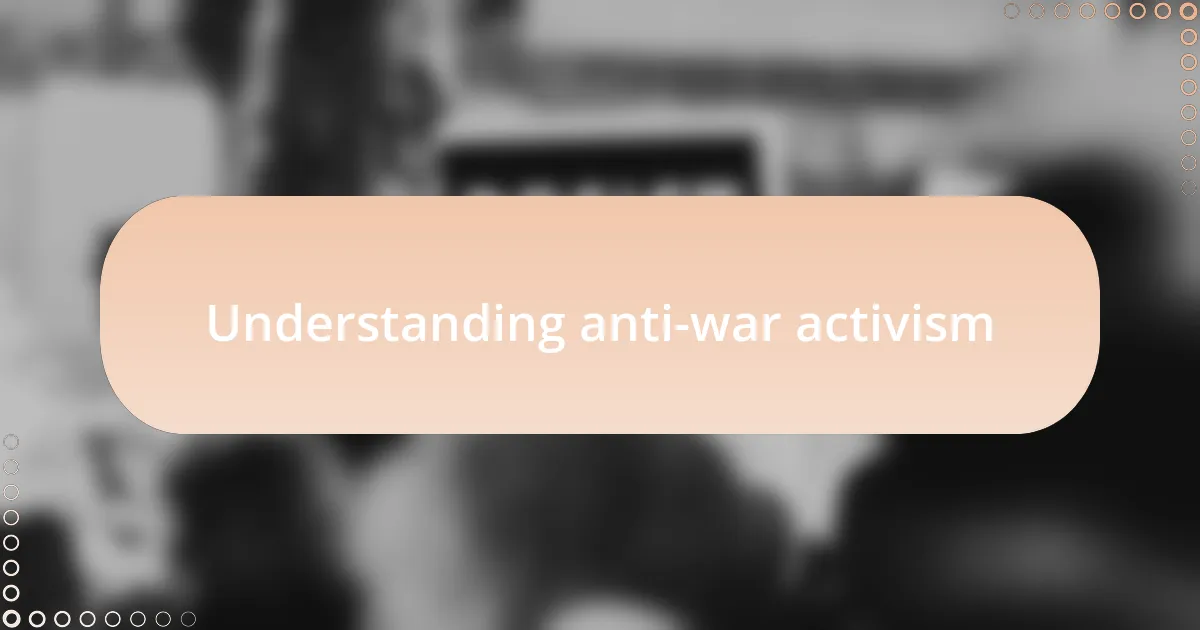
Understanding anti-war activism
Understanding anti-war activism requires a deep dive into both history and the human experience. From my travels, I’ve seen how war impacts lives differently—whether in bustling cities or remote villages. I remember walking through a small town in Eastern Europe, where the scars of past conflicts were still visible in the architecture and the stories the locals shared. It made me realize: how can we ignore the human cost of war when so many are affected?
When I think about what fuels anti-war activism, it’s often the personal stories behind the statistics that resonate most. During a visit to a refugee camp, I met a young mother who spoke of her children’s dreams, now overshadowed by fear. How do we reconcile the desire for peace with the realities of geopolitical turmoil? This question struck me deeply, pushing me to see anti-war efforts not just as political stances but as heartfelt calls for compassion and understanding.
Moreover, the dynamics of anti-war activism differ from one culture to another, shaped by their unique histories. In some countries, protests are vibrant, filled with passionate chants and creative expressions of dissent. I recall participating in a demonstration where art and music played pivotal roles in conveying our message. It was a powerful reminder that activism can take many forms and is often driven by a collective longing for a world where conflict is resolved through dialogue, not violence. What does activism look like in your community?
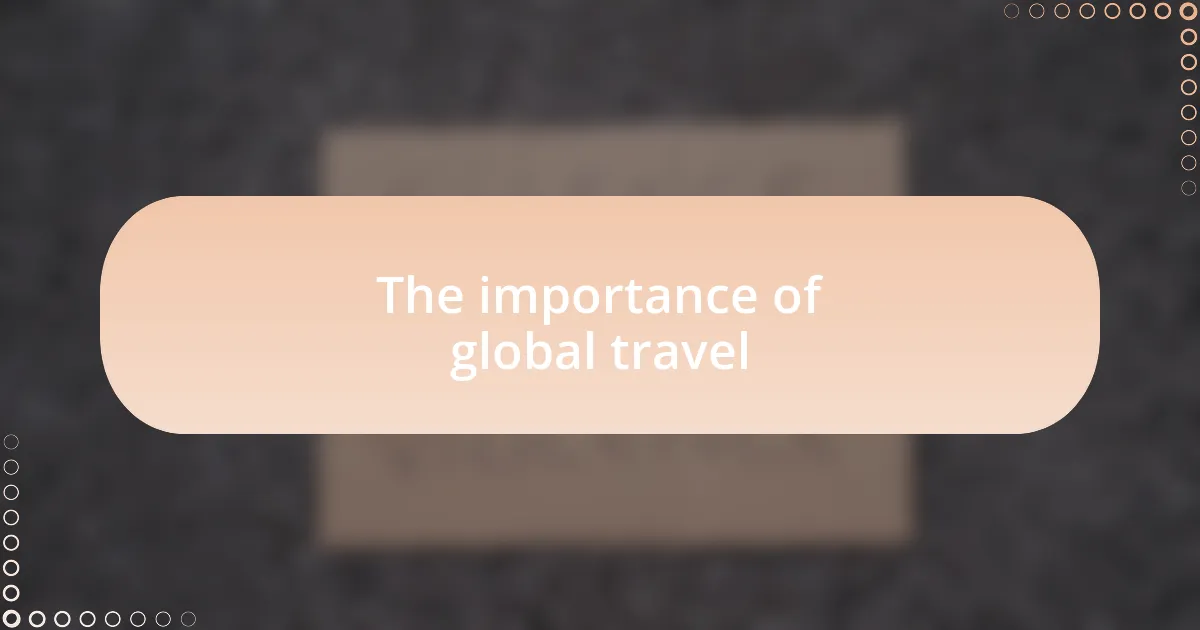
The importance of global travel
Traveling globally has opened my eyes to the interconnectedness of humanity. I recall a moment spent in a bustling market in Morocco, where laughter and bargaining filled the air; it struck me that people everywhere want the same things—safety, happiness, and a better future for their families. How could war disrupt such simple yet profound human desires?
Seeing different cultures in action also highlighted how diverse perspectives shape responses to conflict. I once joined a community event in South America focused on reconciliation after a civil war. It was heartening to witness people coming together to share their stories and heal, revealing that travel can cultivate understanding and empathy in a way that reading or hearing about conflict cannot. Isn’t it fascinating how direct experiences can challenge our preconceived notions?
Moreover, global travel challenges my own views about activism. While journeying through Asia, I encountered street vendors resisting displacement due to urban development. Their resilience inspired me to ask: what does it mean to stand up for one’s rights? These encounters remind me that activism isn’t just about grand gestures; it often starts with local struggles that echo on a universal scale. How many untold stories are waiting to be discovered on our journeys?
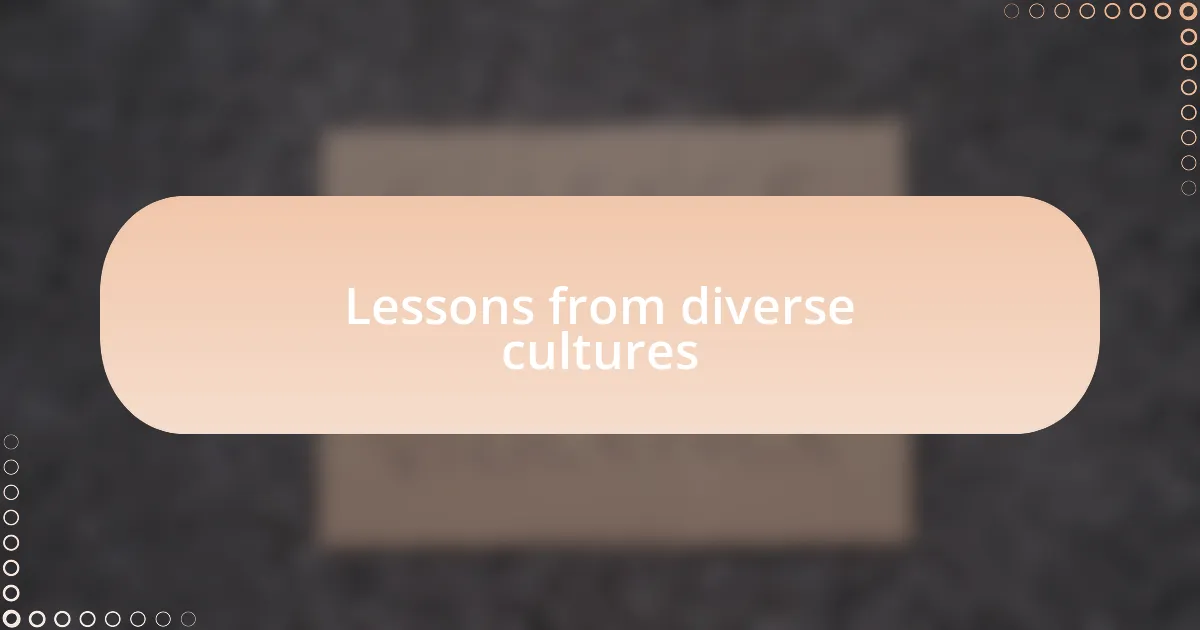
Lessons from diverse cultures
Experiencing diverse cultures during my travels has taught me that compassion often transcends borders. I vividly recall a small village in Southeast Asia where locals gathered to celebrate a festival of gratitude. It was a profound expression of community and togetherness; everyone, regardless of their background, was there to embrace joy. This taught me that while we may come from different places, the human spirit seeks connection and understanding, especially in times of conflict.
In another instance, while learning about Indigenous practices in Australia, I was struck by how these communities prioritize harmony with nature over material gain. This perspective shifted my understanding of success and happiness. I found myself pondering: what if more societies valued harmony over competition? Such lessons from diverse cultures challenge us to reconsider our notions of progress and what truly matters in life.
Moreover, witnessing the resilience of people in regions recovering from conflict has been both inspiring and humbling. For example, in a family-run café in a post-war city, I chatted with the owner, who spoke passionately about rebuilding both his business and his community. His determination made me reflect on the power of grassroots activism. How many stories of resilience and hope could inspire us to act against injustice? Every little encounter reaffirms that in our shared humanity, we hold the power to foster peace and understanding.

Personal experiences impacting views
Navigating bustling markets in Morocco, I encountered a woman tirelessly weaving intricate rugs. As we spoke, she shared stories of her family’s struggles and triumphs amid political unrest. This interaction left me pondering the everyday realities people face—and how resilience can thrive even when surrounded by chaos. I began to understand that such countless personal stories are often overshadowed in broader narratives about war.
Additionally, a quiet moment in a café in Sarajevo struck a chord with me. There, an old man recounted the horrors of war while his eyes sparkled with memories of peace. Listening to him, I felt the weight of his history and how it shaped his outlook on life. This experience forced me to confront my own understanding of conflict—how easy it is to view war through a detached lens instead of recognizing the very real impact on human lives.
Traveling through these experiences, I’ve realized that our perspectives are deeply influenced by personal encounters. Whether it’s a conversation with a street vendor in the heart of Istanbul or sharing laughter with children in refugee camps, each moment shapes my views. How can one witness such human spirit and remain indifferent? I find it increasingly impossible not to advocate for peace as I carry these stories within me.
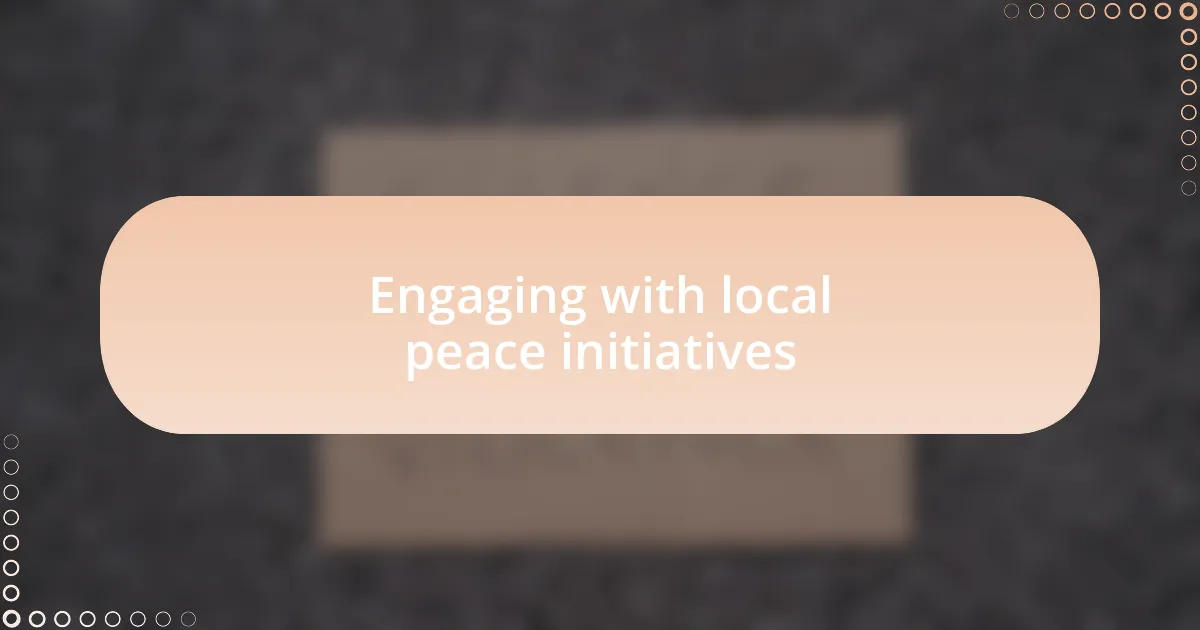
Engaging with local peace initiatives
When I arrived in a small village in Colombia, I was struck by the community’s grassroots efforts to foster peace after years of conflict. I joined a local gathering where residents shared their hopes and dreams, weaving together plans for sustainable development. It made me reflect: how often do we underestimate the power of local initiatives in healing communities? I realized that sometimes, the most impactful change starts from the ground up, led by those directly affected.
While volunteering at a peace festival in Italy, I was inspired by activists from diverse backgrounds coming together. They organized workshops that highlighted the importance of dialogue in resolving conflicts. Participating in one of these workshops, I felt a sense of camaraderie, reminding me that unity can blossom even in the most fragmented societies. What struck me most was how sharing our different experiences can create bridges, turning adversities into collective action.
During my travels in Africa, I encountered women’s groups dedicated to promoting peace through education. Listening to their stories of resilience not only touched my heart but also reignited a spark in me to contribute to such initiatives back home. Isn’t it fascinating how local movements often carry the solutions to broader issues? Their determination showcased the undeniable link between education, empowerment, and sustainable peace.
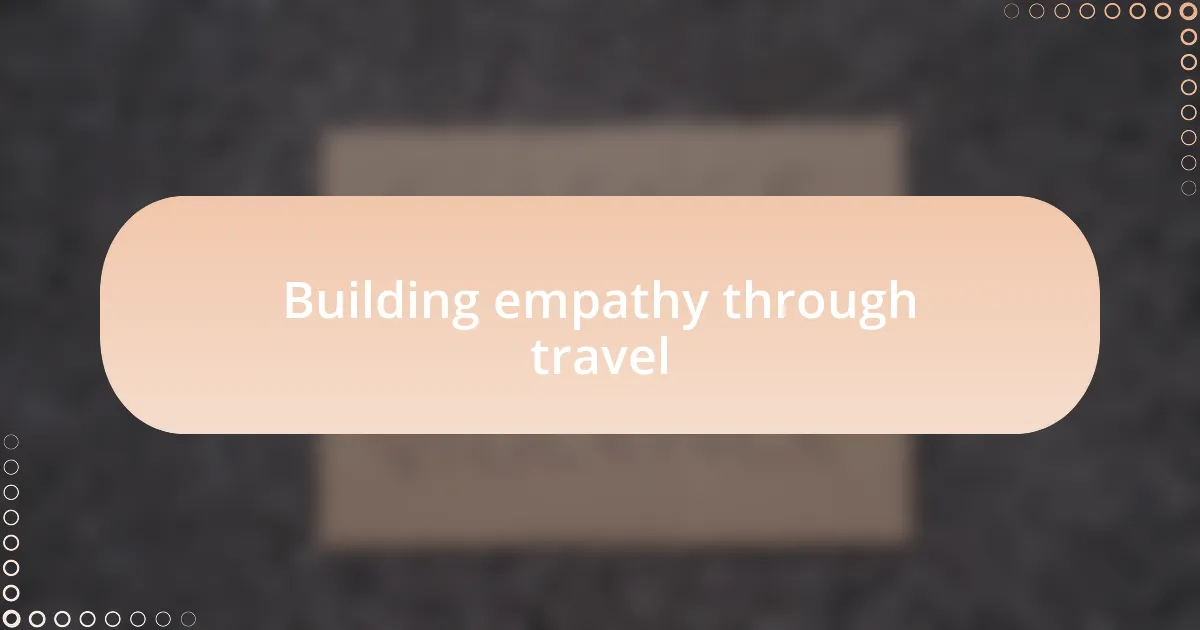
Building empathy through travel
Traveling to different parts of the world has profoundly shaped my understanding of empathy. One evening in a bustling market in Morocco, I struck up a conversation with a local vendor who shared personal stories of hardship and hope. It struck me how our seemingly different lives were linked by common human experiences—struggles, dreams, and the desire for a peaceful existence. How often do we overlook these connections in our daily lives?
On a tranquil hike through the Andes, I met a group of travelers who had volunteered to support displaced families. As we talked about their experiences, I found myself reflecting on the impact of war beyond headlines and statistics. Listening to their heartfelt narratives made the realities of conflict more intimate and urgent for me. Suddenly, I wasn’t just an outsider observing; I felt a connection that compelled me to act.
In a small café in Vietnam, a conversation with an elderly man about his childhood during the war opened my eyes to the long scars that conflict leaves behind. His vivid recounting of loss and resilience illustrated the enduring spirit of communities fighting for peace. What lingered with me was his hope despite the pain he had endured. It’s moments like these that remind me that travel isn’t just about new places; it’s about nurturing empathy that drives change.
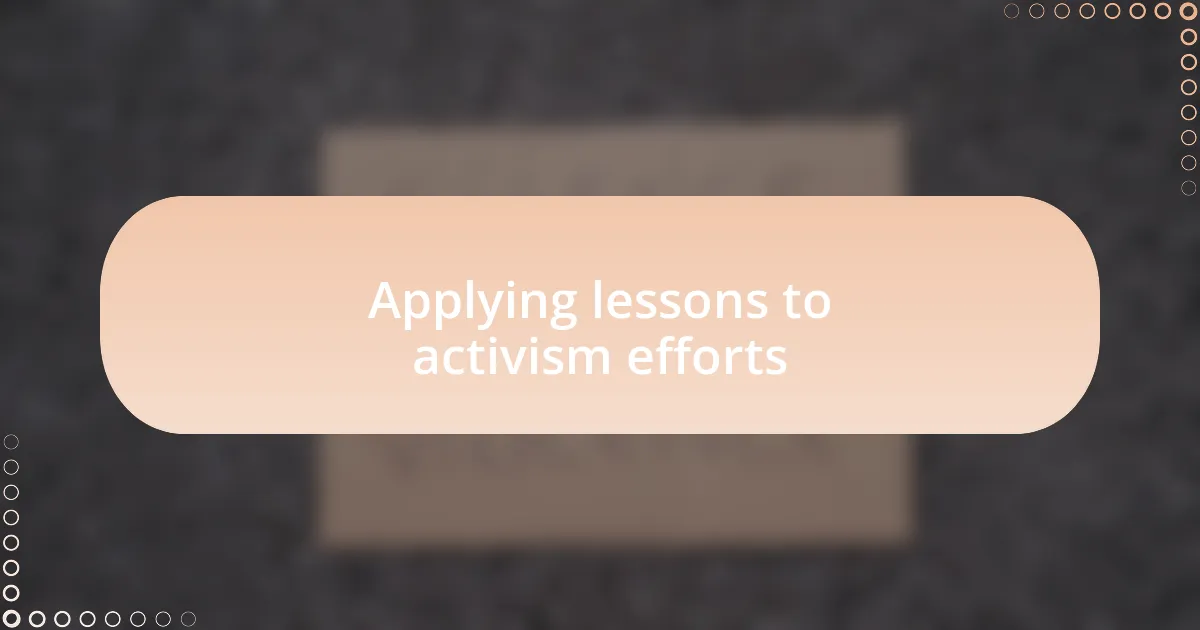
Applying lessons to activism efforts
Connecting the dots between my travels and activism revealed a powerful truth: the stories I encountered became fuel for action. While volunteering at a refugee camp in Greece, I met a woman who shared her journey fleeing war. Her courage ignited something in me; I realized that activism isn’t just about awareness—it’s about amplifying voices that often go unheard. How can we expect to advocate for peace if we don’t fully grasp the experiences of those affected by conflict?
In another instance, during a community workshop in Colombia, I witnessed firsthand how local leaders harnessed their stories to inspire collective action. They organized groups to address the needs of war-impacted communities, reminding me that grassroots movements can be incredibly potent. This experience highlighted a crucial lesson: activism thrives on shared experiences and solidarity. How often do we underestimate the power of collaboration in driving change?
Reflecting on these lessons, I’ve come to understand that activism requires a genuine commitment to listening and learning. It’s not enough to stand on the sidelines; I’ve learned that engaging with affected communities in meaningful ways is essential. Are we truly making an impact if we don’t engage with those at the heart of the issues? Every conversation, every shared story, propels us closer to creating tangible change.